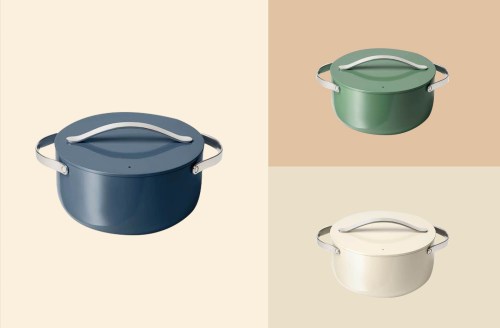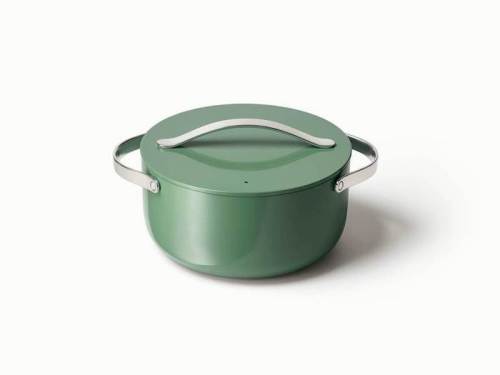Our editors independently select these products. Making a purchase through our links may earn Well+Good a commission
This Beautiful Dutch Oven Might Just Replace All of My Pans
One food writer shares her Caraway cookware review, specifically of its lightweight, relatively affordable Dutch oven. The verdict: It's a winner.

I love to believe that I’m a minimalist. But it takes just one look in my cabinets or my closets to debunk that claim, especially when it comes to my kitchen accessories. Despite living much of my adult life in shoeboxes that pass as homes (hello, New York City apartments and grad school housing), I’ve always owned what could only be described as an inordinate amount of cookware. My long-standing need to have a different pan, pot, and wok for properly cooking each cuisine of the world has really paid off in the times of the pandemic. But today, as an older and wiser version of myself (with more cabinet room than ever), I can honestly say that if I were to keep just one piece from my entire collection, it would be my Caraway Dutch Oven ($125).
I first came across Caraway—a newish direct-to-consumer cookware company—when scouring the internet for a Dutch oven for both my no-knead bread baking and curry-making needs. While mainstays from brands like Le Creuset and Staub certainly do the job well, they carry with them hefty price tags (upwards of $200, depending on the size you purchase). Other startup brands like Made In don’t offer much by way of Dutch ovens (and the carbon steel doesn’t fit my purposes quite as well), whereas Proclamation Goods’s all-in-one “modern” Dutch oven only comes in a seven quart size—a bit too big if you’re cooking for one or two like me. Caraway, however, offers a 6.5 quart ceramic beauty for just $125. (They also make a sauté pan, a sauce pan, and a fry pan.)
Too good to be true, I thought. Never have I ever been more pleased to be wrong.
Buy it: Caraway Dutch Oven, $125
Weighing in at just over six pounds, this is one of the lightest Dutch ovens I’ve encountered. (For comparison, the same-sized Dutch oven from Le Creuset is just over 11 pounds, while the Staub version is 14 pounds with the lid.) When you’re moving a hot Dutch oven from the stove to the oven or vice versa (and it’s filled with dough or stew or what have you), less weight is definitely more functional.
Despite being half the weight of other Dutch ovens, I’ve found that this pan cooks just as well as its top-tier, literal heavyweight counterparts. The pan, like other Dutch ovens, is made from ceramic-coated cast iron—meaning you get all of the benefits of cast-iron cooking (consistent heat, excellent searing, incredibly durable) while being easy to wash and naturally non-stick. I’ve baked many a loaf of bread in my Dutch oven thus far, and have had no issues with sticking whatsoever (even without oiling or buttering). Same goes for cooking rice and frying tofu—no burnt edges or grease stains in sight.
That tofu was part of a larger coconut turmeric rice dish, which was made entirely in my Caraway. I didn’t have to fry the tofu in one pan, then make the curry in another—the Dutch oven is big enough (and versatile enough) where I could fry my protein first then continue using it to make the rest of the meal without a hitch. A word to the wise, though—because ceramic gets hot quickly and stays hot, you’ll want to be careful not to burn yourself on the surface of your cookware, particularly the metal handles.
The entire Caraway line (including the Dutch oven) uses ceramic enameling instead of non-stick Teflon, and doesn’t contain other chemicals common to cookware like perfluorooctanoic acid (PFOA), which is used to make Teflon. Why? Caraway says these materials are potentially toxic (unlike ceramic). While there continues to be debate about Teflon, the substance itself appears not to be toxic, although it starts to degrade at super high heats. Meanwhile, PFOA exposure has been linked to an increased risk of some cancers. Per the American Cancer Society, non-stick cookware is not considered to be a significant source of PFOA exposure. But for many folks in the wellness community, it’s better to be safe than sorry.
Caring for the pan is relatively straightforward, although it has its own unique quirks like other Dutch ovens. For starters, while you’re cooking, be sure not to use metal so that you don’t damage the non-stick coating. (I stick to wooden spoons and spatulas when using the Dutch oven for this reason). This may prove to be frustrating if you’re cooking foods that require a sharper edge to handle. You also can’t put it in the dishwasher, but I’ve found it to be very easy to clean. All you need is some warm, soapy water and a normal sponge to get most food off the surface.
After playing around with my Dutch oven for a few months during quarantine, I would argue that it’s my favorite pan—and certainly one of the best values on the market. There are definitely more affordable Dutch ovens from brands like Lodge and Aidea (both of which are less than $100 for an equivalent size) that are great, but I’m incredibly happy with how well this one works. Of course, if you’re a bit skeptical, fret not—Caraway offers a 30-day trial of its products; if you don’t love it, you can send the products back.
If nothing else, the Caraway Dutch oven has convinced me that I just may be able to live without a dozen other pots and pans. And that in and of itself makes it a winner in my kitchen.
Sign Up for Our Daily Newsletter
Get all the latest in wellness, trends, food, fitness, beauty, and more delivered right to your inbox.
Got it, you've been added to our email list.











